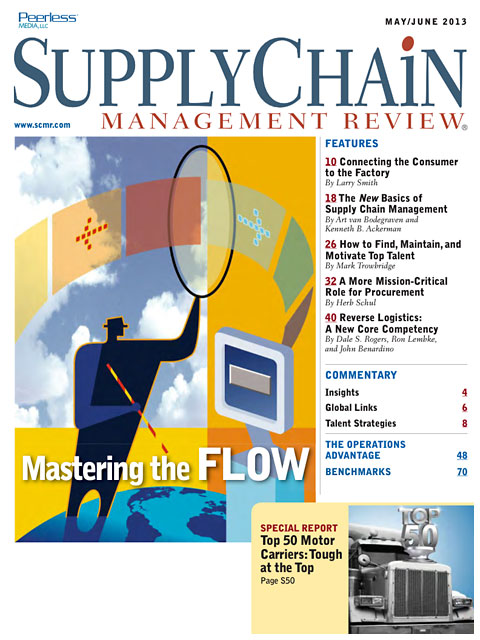Sorry, but your login has failed. Please recheck your login information and resubmit. If your subscription has expired, renew here.
May-June 2013
While supply chain planning based on end-user demand has been applied in the B2B arena for decades, it is only now becoming practical in retail channels. But as distribution resource planning tools and techniques emerge, trading partners can now coordinate their supply chain as if only one company were managing it—effectively connecting the consumer to the factory. Browse this issue archive.Need Help? Contact customer service 847-559-7581 More options
We talk glibly about change in supply chain management—continuous change, managing change, coping with change, even leading change. For all too many of us, those are only words. Truth is, though, that change in our universe is real, fundamental, and visceral.
As definitions of supply chains change, always extending and expanding, far behind are the days when our world was all about quoting rates, tendering loads, and pick/pack/on-time-shipment performance. As we have been required to get proficient in customer service, sourcing and procurement, supplier relationships, Sales & Operations Planning processes, and even occasionally integrating manufacturing to round out our planning and execution responsibilities, some of us have staggered a bit under the load.
We have bad news. Staggering under the load of these new supply chain requirements is no longer an option; we must master all of these elements as well as new ones that are certain to emerge.
 |
This complete article is available to subscribers
only. Click on Log In Now at the top of this article for full access. Or, Start your PLUS+ subscription for instant access. |
Not ready to subscribe, but need this article?
Buy the complete article now. Only $20.00. Instant PDF Download.
Access the complete issue of Supply Chain Management Review magazine featuring
this article including every word, chart and table exactly as it appeared in the magazine.
SC
MR
Sorry, but your login has failed. Please recheck your login information and resubmit. If your subscription has expired, renew here.
May-June 2013
While supply chain planning based on end-user demand has been applied in the B2B arena for decades, it is only now becoming practical in retail channels. But as distribution resource planning tools and techniques… Browse this issue archive. Access your online digital edition. Download a PDF file of the May-June 2013 issue. |
Download Article PDF |
We talk glibly about change in supply chain management—continuous change, managing change, coping with change, even leading change. For all too many of us, those are only words. Truth is, though, that change in our universe is real, fundamental, and visceral.
As definitions of supply chains change, always extending and expanding, far behind are the days when our world was all about quoting rates, tendering loads, and pick/pack/on-time-shipment performance. As we have been required to get proficient in customer service, sourcing and procurement, supplier relationships, Sales & Operations Planning processes, and even occasionally integrating manufacturing to round out our planning and execution responsibilities, some of us have staggered a bit under the load.
We have bad news. Staggering under the load of these new supply chain requirements is no longer an option; we must master all of these elements as well as new ones that are certain to emerge.
 |
SUBSCRIBERS: Click here to download PDF of the full article. |
SC
MR

Latest Supply Chain News
Latest Resources

 Explore
Explore
Topics
Latest Supply Chain News
- Supply chain salaries top $100K for first time
- Supply chain’s rise in prominence brings regulatory compliance into focus
- Inflation continues to have a wide-ranging impact on supply chains
- A reshoring history lesson
- Strategic cost savings differ from cutting costs
- Planning fatigue may be settling in
- More latest news
Latest Resources

Subscribe

Supply Chain Management Review delivers the best industry content.

Editors’ Picks





